Having been largely neglected during the post-Cold War era, the procurement of logistic support ships has undergone a resurgence in recent years. The reasons for this market upsurge are many and varied, including the life-expiry of existing ships, the desirability of meeting enhanced environmental standards, and revised operational concepts that place greater demands on maritime logistic support. The vessels now in the course of construction and delivery are typically a generation-removed from those in existing support ship flotillas, often bringing significant technological evolution. This article reviews some of the main programmes currently underway.
United States
The United States is currently in the course of undertaking the world’s largest logistic support ship acquisition programme. It has a requirement for 20 new fleet replenishment oilers, largely to replace the existing vessels of the ageing Henry J. Kaiser (T-AO-187) class. In contrast to many other fleets, the US Navy mostly operates distinct logistic support ship classes focused primarily on either liquid (fuel and potable water) or solid (food, ammunition and general stores) replenishment requirements, albeit with a capacity to provide a range of consumables of both types. This approach is likely driven by the heavy demands associated with supporting the navy’s carrier strike groups.
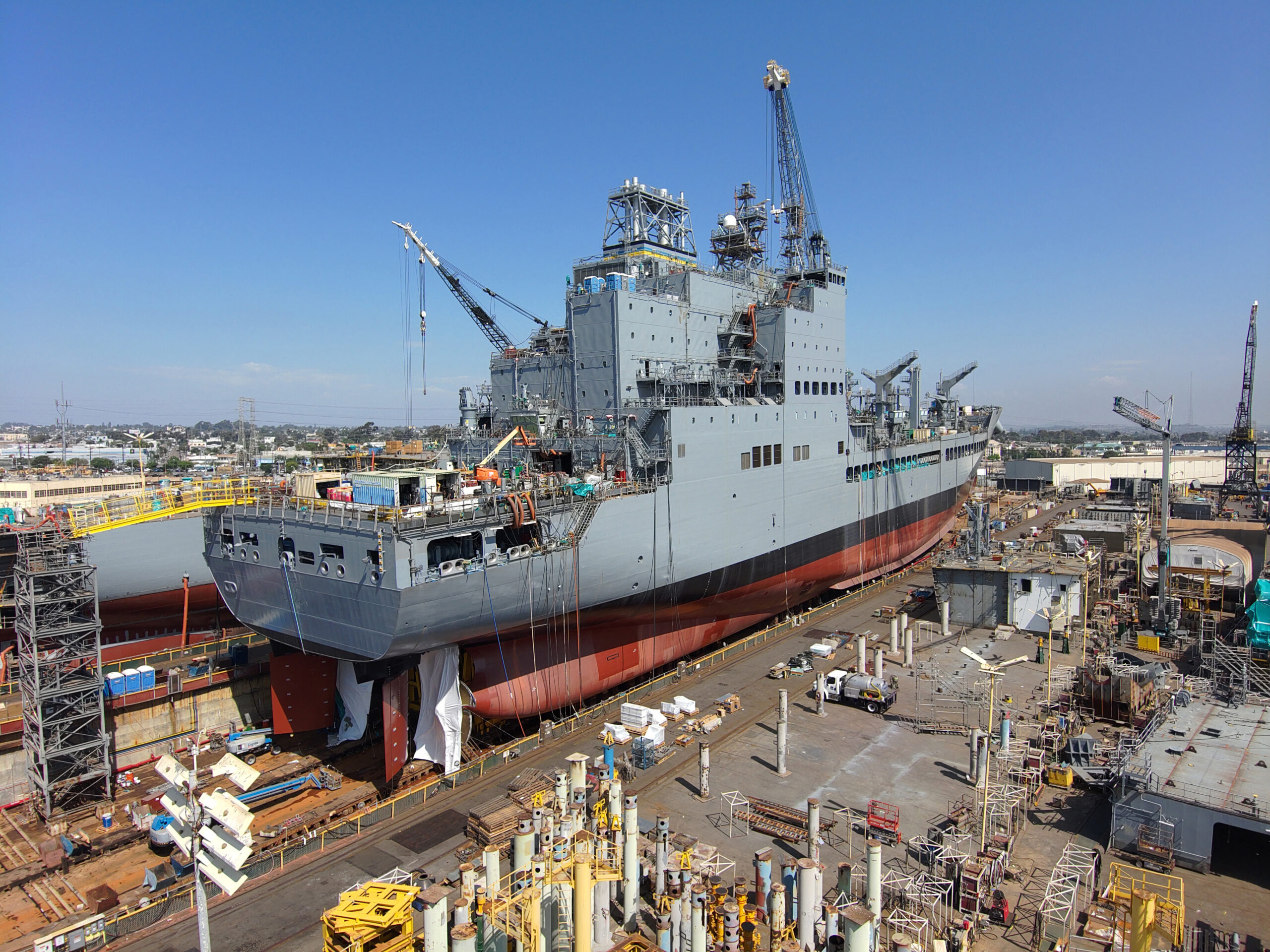
Credit: General Dynamics NASSCO
The current oiler programme originated more than a decade ago as the Future Fleet Replenishment Ship (T-AO-X) project. After conclusion of design studies and a competitive procurement process, General Dynamics NASSCO was awarded a ‘bulk buy’ design and production contract for the first six ships of what became the John Lewis (T-AO-205) class in June 2016. This involved a firm contract for the lead vessel and options for the other five units, all of which have subsequently been exercised. A further three ships were ordered from the shipyard in 2022 and 2023. A further bulk buy announced in September 2024 encompasses an additional eight units, taking production to a total of 17 out of the 20 planned vessels if relevant congressional approvals are forthcoming. To date, the first three members of the class have been delivered.
Displacing nearly 50,000 tonnes when fully loaded, the John Lewis class oilers are able to carry 162,000 barrels of fuel and 200 tonnes of potable water. There is additional capacity for dry and refrigerated stores. A total of five refuelling stations – three to port and two to starboard – are supplemented by a stern refuelling position, two stations for transferring solid cargo and two cargo handling cranes. Provision of a helicopter deck allows a vertical replenishment (VERTREP) capability. Most defensive capabilities are provided on a ‘fitted for but not with’ basis.
The John Lewis class was deliberately configured to reduce project risk by avoiding the specification of new technologies. Despite this, the ships reflect modern design practices that include the use of a double hull in line with environmental standards for commercial tankers. Their hull form also incorporates a twin skeg arrangement, with two shaft-lines and twin rudders assisting manoeuvrability and reliability during potentially hazardous replenishment operations. The main propulsion system utilises two 14.4 MW Fairbanks Morse MAN 12V 48/60 CR main diesels linked to the shafts by reduction gearing. A power take-off/power take-in (PTO/PTI) capability provides additional operating flexibility.
In common with many other US Navy projects, the oiler programme is proving expensive to implement. The lead ship cost USD 716 million when delivered in 2022; USD 76 million more than originally envisaged. The latest eight ship block buy has a reported cost of USD 6.75 billion (just over USD 840 million per unit). Moreover, the implications of the navy’s Distributed Maritime Operations (DMO) concept are putting upward pressure on logistic support requirements. A new T-AOL ‘Light Replenishment Oiler’ is therefore now under development to provide a cheaper vessel to supplement the T-AO-205 design. It is hoped that the first of these will be authorised during FY2027 at a cost of around USD 450 million; more than three times the initial estimate. A programme encompassing 13 of these ships is currently envisaged.
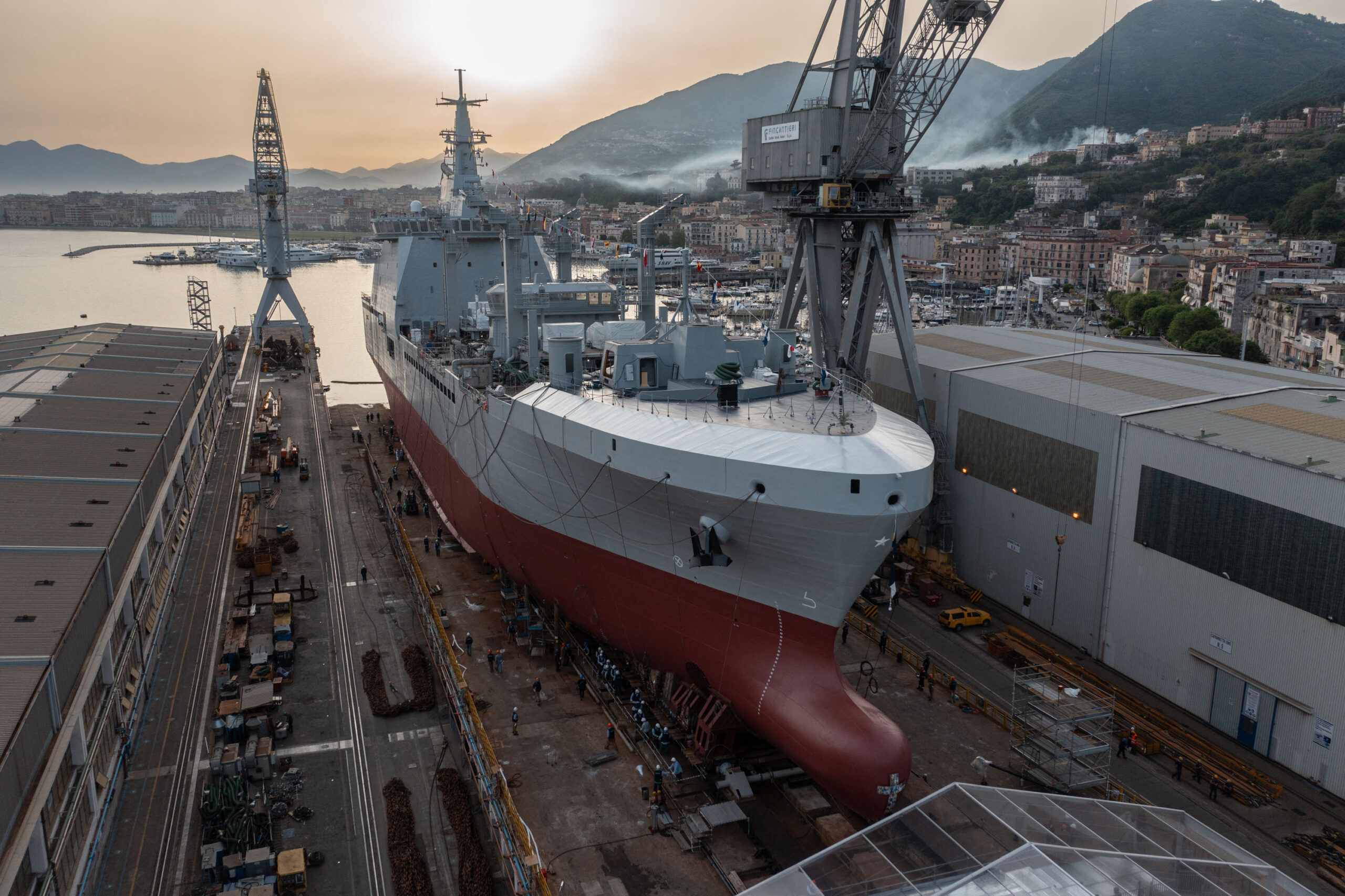
Credit: Fincantieri
France & Italy
Turning to Europe, the continent’s most significant logistic support ship programme involves the acquisition of four vessels each by France and Italy to a broadly common Italian Fincantieri design. Their construction has its origins in the order for the Italian Navy’s logistic support ship ITS Vulcano; one of a number of vessels that were authorised as part of a programme of fleet renewal under the so-called ‘Naval Law’ of 2014. Commissioned in March 2021 after delays caused by an onboard fire and the subsequent Covid-19 pandemic, she is being followed by a second vessel – Atlante – ordered in December that year. The two additional units are still in the planning phase. The lead ship was integrated at Fincantieri’s Muggiano shipyard near La Spezia from sections fabricated at nearby Riva Trigoso and at Castellammare di Stabia near Naples. However, the last-mentioned facility will take sole responsibility for the other Italian Navy ships. Together, the Vulcano class will replace three Stromboli and Etna class support vessels. The final cost of Vulcano was EUR 375 million, whilst the order for her sister Atlante was valued at EUR 410 million.
The selection of the Vulcano design to meet France’s FLOTLOG requirement to replace its Durance class fleet replenishment oilers can be traced to Fincantieri’s ultimately abortive plans to acquire the Chantiers de l’Atlantique shipyard at Saint-Nazaire, where the new vessels were to be assembled. The decision to adapt the Italian design to French requirements replaced previous proposals based on a Naval Group logistic support ship concept known as BRAVE. An order for four units that are officially designated ‘bâtiments ravitailleurs de forces’ (BRFs) was placed in January 2019 at a reported cost of EUR 1.7 billion. Although Naval Group’s design was not selected for construction, they form part of the winning consortium with an important systems-integration role. Assembly of all four ships will take place at Chantiers de l’Atlantique from sections constructed at that yard and at Castellammare di Stabia. The lead ship, FS Jacques Chevallier, was officially delivered in July 2023 after an extensive series of trials. The second and third vessels are presently at various stages of construction.
In contrast to US Navy practice, the Vulcano class and their French derivatives are true multi-role logistic support ships with a relatively greater emphasis on carrying ammunition and other dry stores than the John Lewis class. There is also extensive provision for repair and maintenance activities, whilst a fully-equipped (NATO ‘Role 2’) hospital is incorporated in line with a post-Cold War ‘dual use’ ethos supporting humanitarian and crisis response activities. Displacing around 27,000 tonnes at full load, the Italian variants can reportedly carry around 14,500 m³ of liquids within their double hulls. This is supplemented by some 220 tonnes of ammunition, additional other solid stores, and eight ISO 20 containers. Two replenishment at sea (RAS) stations for liquid and solid stores are located to both port and starboard, with a stern refuelling station, two cranes and VERTREP providing additional replenishment options. A combined-diesel electric and diesel (CODLAD) propulsion system linked to twin shaft lines is more flexible than traditional all-diesel powered solutions. It provides high endurance whilst allowing a useful maximum speed of 20 knots.
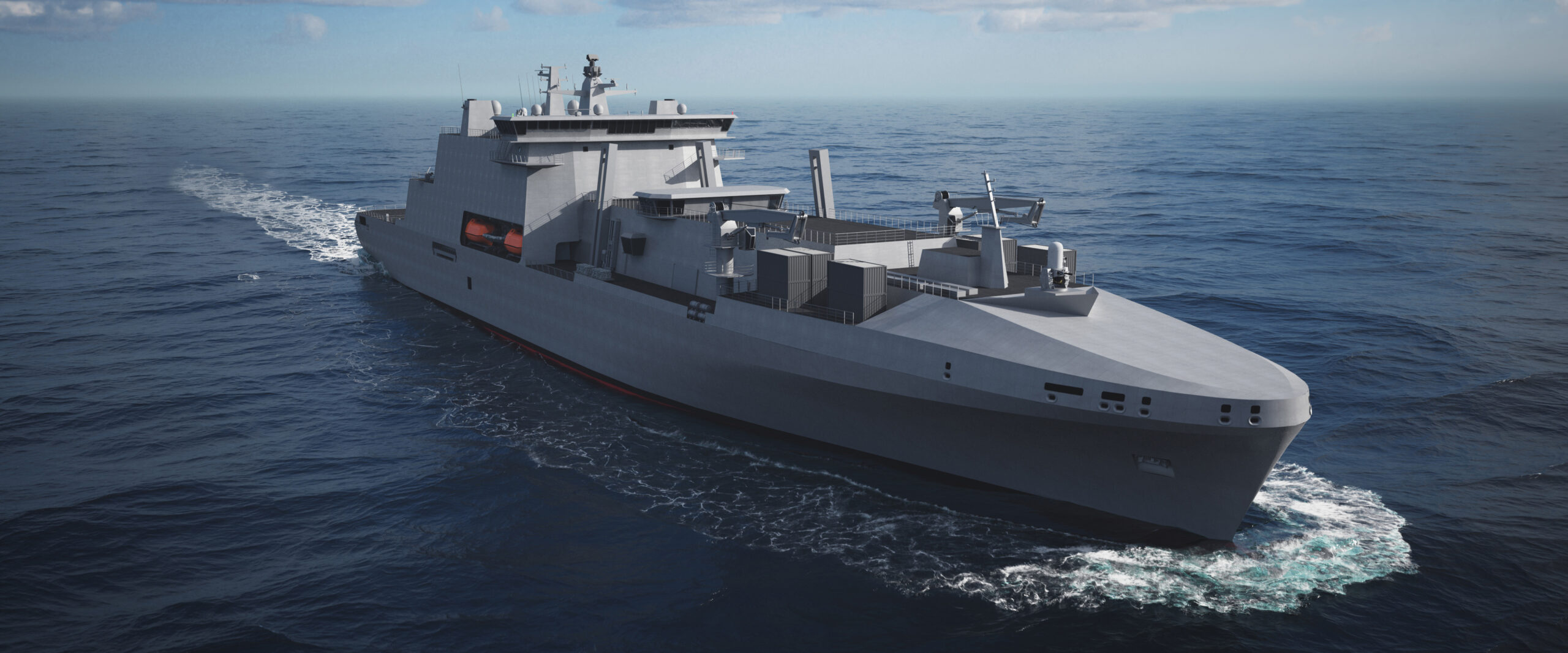
The French Jacques Chevallier class vessels incorporate various differences from their Italian counterparts, perhaps most visibly evident in a revised bow form. Displacing some 31,000 tonnes, they are also broader than the Italian ships and have greater cargo carrying capacity. Another important difference is the specification of an all-electric propulsion system that uses GE Vernova-manufactured electric motors supplied by MAN diesel generators. In common with the Italian ships, the French vessels have better ‘as fitted’ defensive capabilities than their American counterparts, as well as a greater command and control capability. This reflects the greater likelihood of their operating outside of the protective umbrella of a carrier strike group, as well as the smaller number of large ships available to perform a command role.
United Kingdom
Having already modernised its force of fleet tankers with the British-designed but South Korean-built ‘Tide’ class, the United Kingdom is now embarking on the construction of three Fleet Solid Support (FSS) ships in an approach reflective of the US Navy’s split of its combat logistics force between liquid and solid replenishment. The new vessels’ primary role will be resupplying the British Royal Navy’s Queen Elizabeth class aircraft carriers with ammunition and other general stores.
Following a protracted procurement process, a consortium (Team Resolute) led by Navantia was selected as preferred bidder for construction of the ships in late 2022. This was followed by a GBP 1.6 billion contract in January 2023. Assembly of the ships is to be carried out at the Harland & Wolff shipyard in Belfast from sections built in both Spain and the United Kingdom, with construction of the lead vessel expected to begin in 2025 for entry into service during the early 2030s. These plans may be impacted by the financial insolvency of the Harland & Wolff group parent company in September 2024.
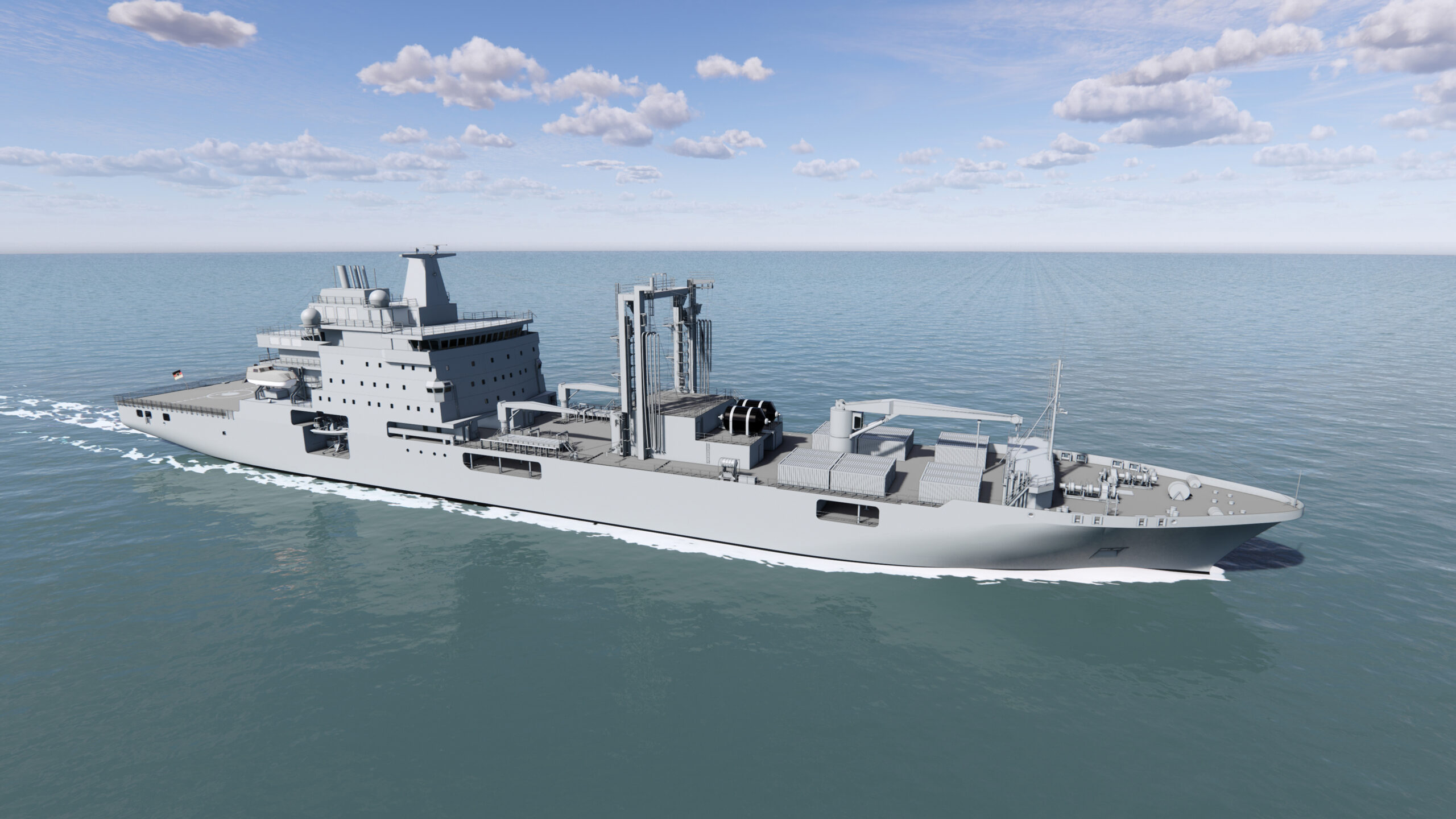
Credit: Copyright NVL
Whilst construction is being overseen by Navantia, the actual FSS design has been produced by the British BMT Group, which was previously responsible for both the four ‘Tide’ class tankers and the single Norwegian logistic support ship, KNM Maude. The new solid support ships are reportedly derived from the ‘Aegir’® design concept that inspired these earlier vessels, albeit with altered hull lines to reflect the different type of cargo carried. As such, they utilise the twin skeg design and combined diesel-electric propulsion system seen in these previous design iterations. Displacing nearly 40,000 tonnes, the as-yet-unnamed class will reportedly have over 7,000 m³ of stores capacity dispensed from three RAS positions.
Germany
The German Navy is also modernising its fleet replenishment capability, acquiring two Type 707 replenishment tankers to replace its elderly Type 704 Rhön class vessels. The new ships were contracted with Germany’s NVL in July 2021 after receipt of parliamentary approval the previous month. Much of the actual construction effort is being focused on Meyer Werft’s shipyards in Rostock and Papenburg. The keels of the two tankers were laid in Rostock in August 2023 and April 2024 respectively. The lead ship was subsequently floated out in June 2024 prior to an anticipated delivery in 2025. After some reduction in the programme’s scope, estimated cost is nearly EUR 915 million. This figure has attracted some criticism.
Displacing some 20,000 tonnes, the Type 707 is a modern, double-hulled design with an emphasis on environmental compliance. In comparison with Germany’s other large logistic support vessels – the Type 702 Berlin class combat support ships – the focus is on carrying a greater volume of liquid stores (almost 13,000 m³) at the expense of overall flexibility. Accordingly, provision for solid cargo largely restricted to 10 containerised positions and medical facilities are also more limited. Replenishment is carried out from three positions; one on each beam and one astern. Propulsion is by a single, diesel-powered shaft supplemented by a PTO/PTI arrangement.
The publication of the German Navy’s ‘Vision 2035+’ fleet structure plan in March 2023 indicates a requirement for three replenishment tankers, suggesting that an order for an additional vessel will be placed in due course. The same document also outlines a requirement for a flotilla of six smaller support ships to replace the existing Type 404 Elbe class tenders. Whilst no details on specific characteristics have been released to date, NVL has publicised its NTV 130 concept as a possible design solution. Reportedly displacing around 14,000 tonnes, NTV 130 is heavily influenced by the current trend favouring modular, containerised equipment.
In the meantime, the Type 702 Berlin class design is also being used as the basis of Canada’s construction of two Protecteur class joint support ships by Seaspan ULC in Vancouver. After considerable delays, the lead ship is expected to be launched before the end of 2024. Keel laying for her sister, HMCS Preserver, took place in October 2023.

Credit: Damen
Other selected acquisition programmes
Elsewhere in Europe, Damen is close to completing the new combat support ship HNLMS Den Helder, which was ordered from Damen in February 2020. In common with many other Royal Netherlands Navy vessels, much of its construction has been carried out at the company’s Romanian yard in Galati. However, final systems’ integration will be performed ‘in country’ at Vlissingen. Displacing around 22,500 tonnes, Den Helder can carry nearly 9,000 m³ of liquids, around 400 tonnes of solid stores and 20 containers. She is equipped with two main replenishment positions. Propulsion is by means of two GE Vernova electric motors supplied by four Wärtsilä diesel generators.
Turkey is also another major builder of logistic support ships, constructing vessels both for the Turkish Navy and export. Its most significant recent programme is for the fast combat support ship TCG Derya. She was built by the Sefine Shipyard and commissioned in January 2024. Displacing nearly 26,500 tonnes she is unusual in utilising twin GE LM2500 gas turbines as a primary form of propulsion, allowing her to achieve a relatively high maximum speed of 24 knots at the cost of restricted endurance. Some sources also credit her with auxiliary diesel-electric propulsion. Other characteristics are broadly similar to other contemporary logistic support ships. This included capacity for about 11,000 m³ of liquid stores and 48 containers. Replenishment is carried out from two main RAS stations on either beam.
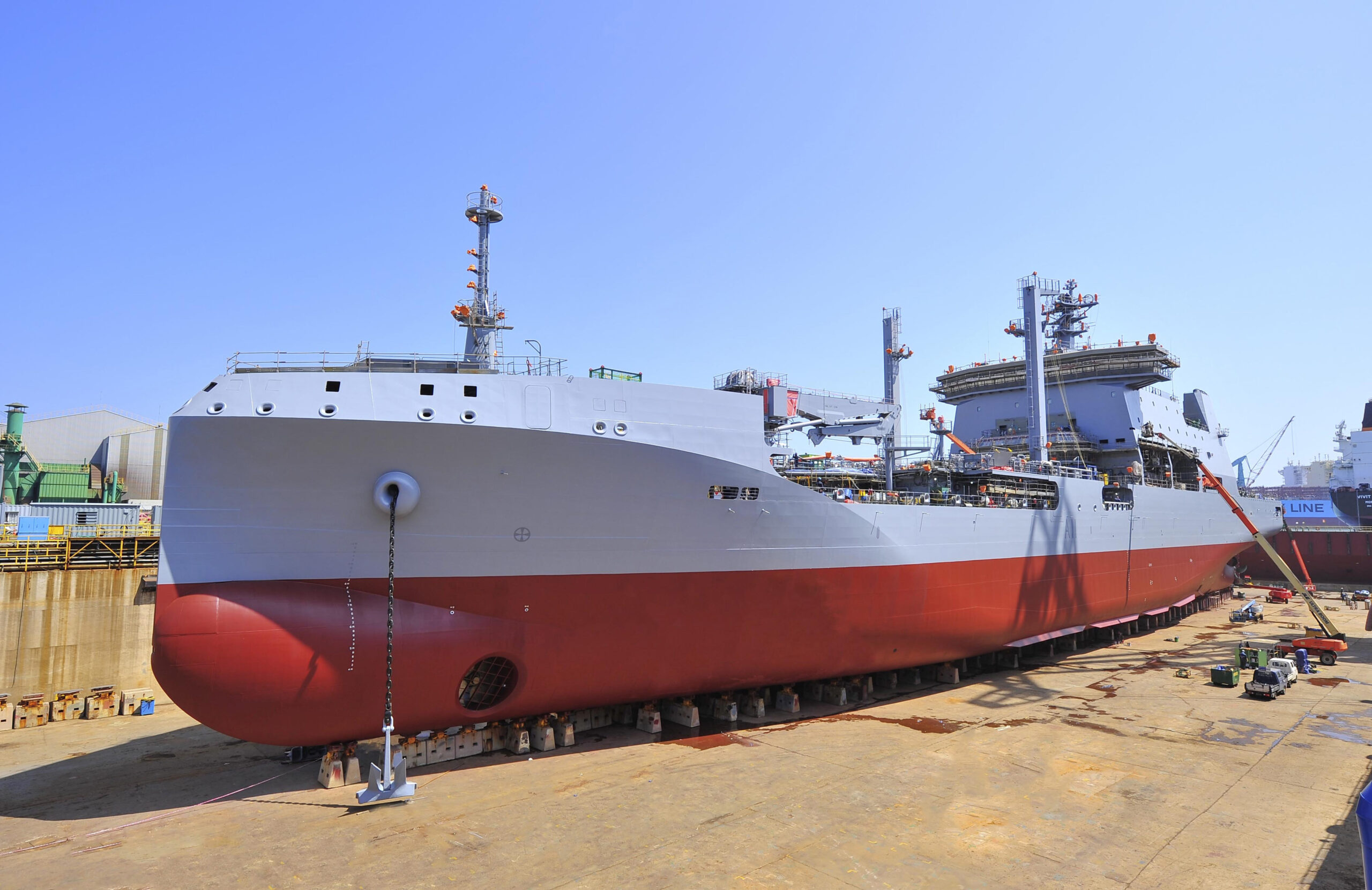
Credit: Royal New Zealand Navy
The other major focal point of logistic support ship construction is Asia. South Korea’s powerful shipbuilding sector has carried out a number of projects for the Republic of Korea Navy and for export, including the ‘Tide’ class and Maude referenced above. A particularly innovative project was the Royal New Zealand Navy’s HMNZS Aotearoa, which was built by Hyundai Heavy Industries and commissioned in July 2020. Intended for regular deployment to the Southern Ocean and Antarctica, she incorporates a degree of ice-strengthening and ‘winterisation’, whilst utilising a wave-piercing, axe bow hull form for better seagoing performance.
Future years will bring new programmes, new builders and new designs into the mix. Notably Japan is beginning the renewal of its flotilla of replenishment ships, obtaining approval for a new 14,500 tonne (light displacement) logistic support ship in its recent, FY2024 budget. Another significant development took place in August 2023 with India’s long-awaited order for five 45,000 tonne fleet support vessels from Hindustan Shipyard Ltd at a cost of INR 190 billion (USD 2.3 billion). The ships were to be built to a design provided by Turkey’s TAIS but local reports suggest that the company was dropped from the deal for political reasons. It seems probable that other significant new programmes will be launched as developing navies realise the imperative of fielding effective logistical and replenishment support to advance their ‘blue water’ naval ambitions. From a technological standpoint, the ongoing trend towards modular solutions reflected in vessels such as NVL’s NTV 130 will likely remain a key consideration. The need to sustain the growing number of autonomous naval vehicles will likely be another important future design influence.
Conrad Waters



